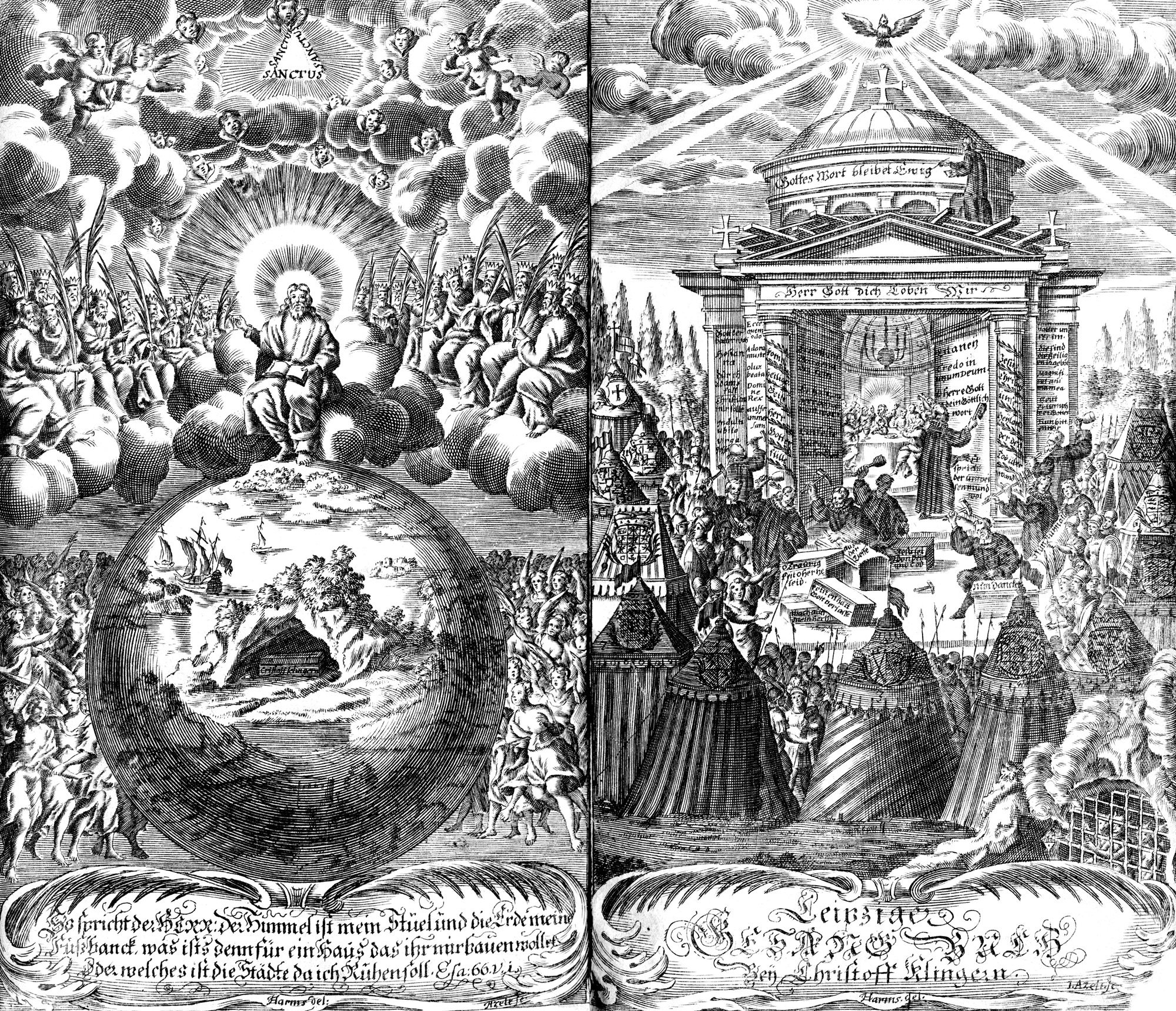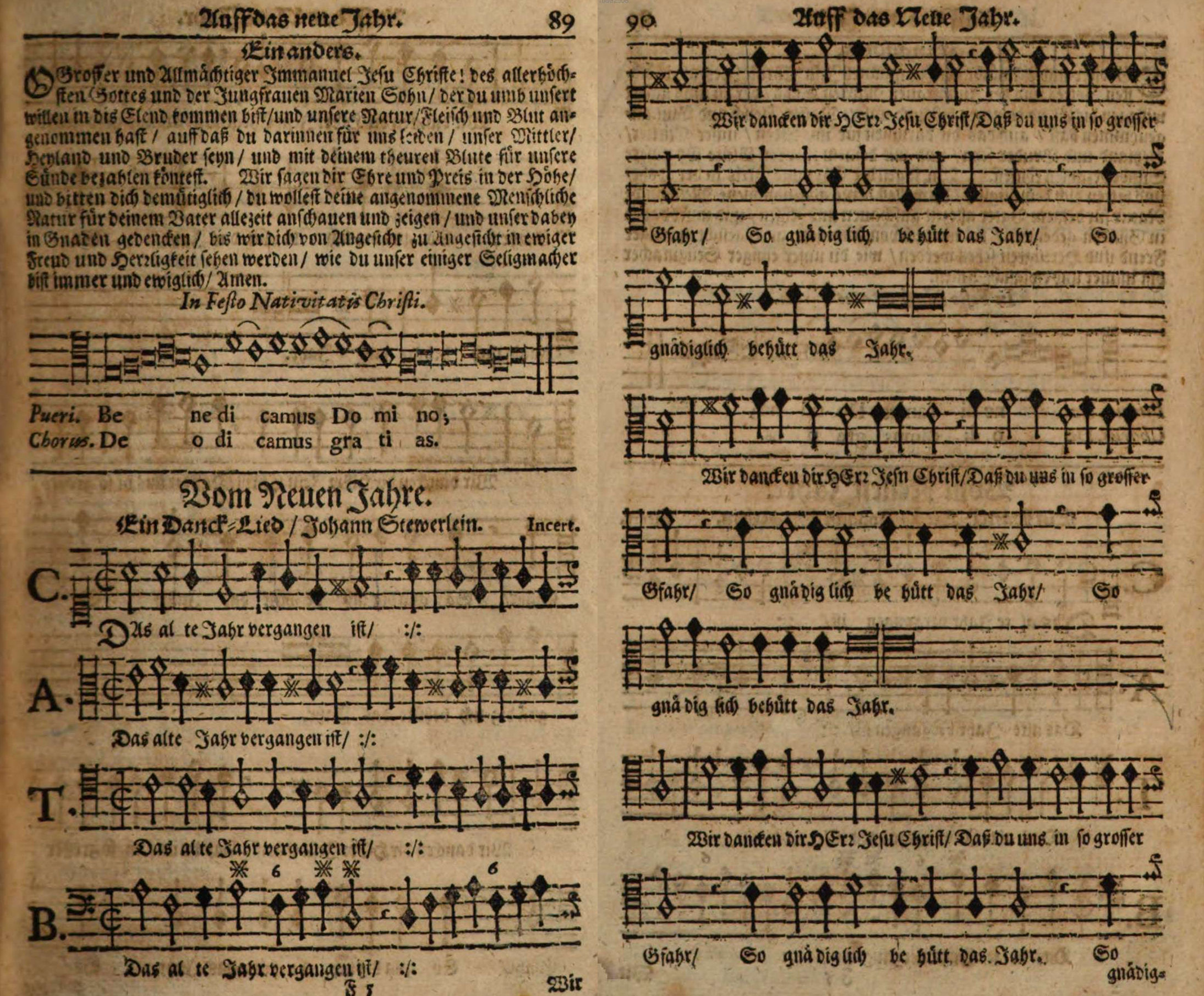|
Meinen Jesum Laß Ich Nicht
"" ("I shall not leave my Jesus") is a German Lutheran hymn, with lyrics by Christian Keimann written in 1658. The theme of the hymn is trust in Jesus, based on memorial sermons for John George I, Elector of Saxony recalling conversations of the elector with his minister on his deathbed. The hymn inspired composers to vocal settings. Johann Sebastian Bach based his chorale cantata ''Meinen Jesum laß ich nicht'', BWV 124 on the first melody by Andreas Hammerschmidt ( Zahn No. 3449), and Max Reger used a later melody by Johann Ulich for a chorale cantata in 1906. The hymn appears, with Ulich's tune, in the Protestant hymnal '' Evangelisches Gesangbuch'' as EG 402, in modernized German as "Meinen Jesus lass ich nicht". History Christian Keimann worked as director of a Gymnasium in Zittau when he wrote the hymn. It was first published in Andreas Hammerschmidt's choral book ''Fest-, Buß- und Danklieder'' (Songs of feast, penitence and thanks) of 1659, and was probably wr ... [...More Info...] [...Related Items...] OR: [Wikipedia] [Google] [Baidu] |
Hymn
A hymn is a type of song, and partially synonymous with devotional song, specifically written for the purpose of adoration or prayer, and typically addressed to a deity or deities, or to a prominent figure or personification. The word ''hymn'' derives from Greek (''hymnos''), which means "a song of praise". A writer of hymns is known as a hymnist. The singing or composition of hymns is called hymnody. Collections of hymns are known as hymnals or hymn books. Hymns may or may not include instrumental accompaniment. Although most familiar to speakers of English in the context of Christianity, hymns are also a fixture of other world religions, especially on the Indian subcontinent ('' stotras''). Hymns also survive from antiquity, especially from Egyptian and Greek cultures. Some of the oldest surviving examples of notated music are hymns with Greek texts. Origins Ancient Eastern hymns include the Egyptian '' Great Hymn to the Aten'', composed by Pharaoh Akhenaten; the Hu ... [...More Info...] [...Related Items...] OR: [Wikipedia] [Google] [Baidu] |
Gymnasium (Germany)
''Gymnasium'' (; German plural: ''Gymnasien''), in the German education system, is the most advanced and highest of the three types of German secondary schools, the others being '' Hauptschule'' (lowest) and '' Realschule'' (middle). ''Gymnasium'' strongly emphasizes academic learning, comparable to the British sixth form system or with prep schools in the United States. A student attending ''Gymnasium'' is called a ''Gymnasiast'' (German plural: ''Gymnasiasten''). In 2009/10 there were 3,094 gymnasia in Germany, with students (about 28 percent of all precollegiate students during that period), resulting in an average student number of 800 students per school.Federal Statistical office of Germany, Fachserie 11, Reihe 1: Allgemeinbildende Schulen – Schuljahr 2009/2010, Wiesbaden 2010 Gymnasia are generally public, state-funded schools, but a number of parochial and private gymnasia also exist. In 2009/10, 11.1 percent of gymnasium students attended a private gymnasium. T ... [...More Info...] [...Related Items...] OR: [Wikipedia] [Google] [Baidu] |
Lutheran Hymns
Lutheranism is one of the largest branches of Protestantism, identifying primarily with the theology of Martin Luther, the 16th-century German monk and reformer whose efforts to reform the theology and practice of the Catholic Church launched the Protestant Reformation. The reaction of the government and church authorities to the international spread of his writings, beginning with the ''Ninety-five Theses'', divided Western Christianity. During the Reformation, Lutheranism became the state religion of numerous states of northern Europe, especially in northern Germany, Scandinavia and the then-Livonian Order. Lutheran clergy became civil servants and the Lutheran churches became part of the state. The split between the Lutherans and the Roman Catholics was made public and clear with the 1521 Edict of Worms: the edicts of the Diet condemned Luther and officially banned citizens of the Holy Roman Empire from defending or propagating his ideas, subjecting advocates of Lutheranism to ... [...More Info...] [...Related Items...] OR: [Wikipedia] [Google] [Baidu] |
Bertelsmann
Bertelsmann SE & Co. KGaA () is a German private multinational conglomerate corporation based in Gütersloh, North Rhine-Westphalia, Germany. It is one of the world's largest media conglomerates, and is also active in the service sector and education. Bertelsmann was founded as a publishing house by Carl Bertelsmann in 1835. After World War II, Bertelsmann, under the leadership of Reinhard Mohn, went from being a medium-sized enterprise to a major conglomerate, offering not only books but also television, radio, music, magazines and services. Its principal divisions include the RTL Group, Penguin Random House, BMG, Arvato, the Bertelsmann Printing Group, the Bertelsmann Education Group and Bertelsmann Investments. Bertelsmann is an unlisted and capital market-oriented company, which remains primarily controlled by the Mohn family. History 1835 to 1933 The nucleus of the corporation is the ''C. Bertelsmann Verlag'', a publishing house established on July ... [...More Info...] [...Related Items...] OR: [Wikipedia] [Google] [Baidu] |
Die Melodien Der Deutschen Evangelischen Kirchenlieder (Zahn, Johannes)
A Lutheran chorale is a musical setting of a Lutheran hymn, intended to be sung by a congregation in a German Protestant Church service. The typical four-part setting of a chorale, in which the sopranos (and the congregation) sing the melody along with three lower voices, is known as a ''chorale harmonization''. Lutheran hymns Starting in 1523, Martin Luther began translating worship texts into German from the Latin. He composed melodies for some hymns himself, such as "Ein feste Burg ist unser Gott" ("A Mighty Fortress Is Our God"), and even a few harmonized settings. For other hymns he adapted Gregorian chant melodies used in Catholic worship to fit new German texts, sometimes using the same melody more than once. For example, he fitted the melody of the hymn " Veni redemptor gentium" to three different texts, " Verleih uns Frieden gnädiglich", " Erhalt uns, Herr, bei deinem Wort", and " Nun komm, der Heiden Heiland". The first Lutheran hymns were published in 1524. These i ... [...More Info...] [...Related Items...] OR: [Wikipedia] [Google] [Baidu] |
Totensonntag
Totensonntag (''Sunday of the Dead''), also called Ewigkeitssonntag (''Eternity Sunday'') or Totenfest, is a Protestant religious holiday in Germany and Switzerland, commemorating the faithfully departed. It falls the last Sunday of the liturgical year in the Evangelical Church in Germany and the Protestantse Kerk in The Netherlands. History With development of the liturgical year in the Middle Ages, readings on the last things were connected with the last Sundays of the liturgal year. While on the antepenultimate Sunday the focus is on death, the penultimate Sunday has the topic Last Judgment and the last Eternal Life. Traditionally, the last Sunday of the liturgical year deals in a special way with the expectation of Judgment Day. The Gospel is that of Parable of the Ten Virgins. In 1816, King Frederick William III of Prussia issued a decree that required all Lutheran churches in the areas under Prussian rule to observe the last Sunday before Advent as a "general celebrati ... [...More Info...] [...Related Items...] OR: [Wikipedia] [Google] [Baidu] |
Leipzig University
Leipzig University (german: Universität Leipzig), in Leipzig in Saxony, Germany, is one of the world's oldest universities and the second-oldest university (by consecutive years of existence) in Germany. The university was founded on 2 December 1409 by Frederick I, Elector of Saxony and his brother William II, Margrave of Meissen, and originally comprised the four scholastic faculties. Since its inception, the university has engaged in teaching and research for over 600 years without interruption. Famous alumni include Gottfried Wilhelm von Leibniz, Johann Wolfgang von Goethe, Leopold von Ranke, Friedrich Nietzsche, Robert Schumann, Richard Wagner, Tycho Brahe, Georgius Agricola, Angela Merkel and ten Nobel laureates associated with the university. History Founding and development until 1900 The university was modelled on the University of Prague, from which the German-speaking faculty members withdrew to Leipzig after the Jan Hus crisis and the Decree of ... [...More Info...] [...Related Items...] OR: [Wikipedia] [Google] [Baidu] |
St Matthew Passion
The ''St Matthew Passion'' (german: Matthäus-Passion, links=-no), BWV 244, is a '' Passion'', a sacred oratorio written by Johann Sebastian Bach in 1727 for solo voices, double choir and double orchestra, with libretto by Picander. It sets the 26th and 27th chapters of the Gospel of Matthew (in the Luther Bible) to music, with interspersed chorales and arias. It is widely regarded as one of the greatest masterpieces of Baroque sacred music. The original Latin title translates to "The Passion of our Lord J susC[hrist">rist.html" ;"title="susC[hrist">susC[hristaccording to the Evangelist Matthew".Markus Rathey. 2016. ''Bach's Major Vocal Works. Music, Drama, Liturgy'', Yale University Press History The ''St Matthew Passion'' is the second of two Passion settings by Bach that have survived in their entirety, the first being the ''St John Passion'', first performed in 1724. Versions and contemporaneous performances Little is known with certainty about the creation proce ... [...More Info...] [...Related Items...] OR: [Wikipedia] [Google] [Baidu] |
Neu Leipziger Gesangbuch
Gottfried Vopelius (28 January 1645 – 3 February 1715), was a German Lutheran academic and hymn-writer, mainly active in Leipzig. He was born in Herwigsdorf, now a district of Rosenbach, Oberlausitz, and died in Leipzig at the age of 70. Robert Eitner. " Vopelius, Gottfried", pp. 298–299 in Vol. 40 of ''Allgemeine Deutsche Biographie ''Allgemeine Deutsche Biographie'' (ADB, german: Universal German Biography) is one of the most important and comprehensive biographical reference works in the German language. It was published by the Historical Commission of the Bavarian Aca ...''. , 1896. ''Neu Leipziger Gesangbuch'' Vopelius is primarily remembered for the ''Neu Leipziger Gesangbuch'' (New Leipzig Hymnal) which he published in 1682. The subtitle of the publication reads: Or, translated: The ''Neu Leipziger Gesangbuch'' is, to a certain degree, a third edition of Johann Schein's , which originally had been published in 1627, with a new edition in 1645. ... [...More Info...] [...Related Items...] OR: [Wikipedia] [Google] [Baidu] |
Vopelius
Gottfried Vopelius (28 January 1645 – 3 February 1715), was a German Lutheran academic and hymn-writer, mainly active in Leipzig. He was born in Herwigsdorf, now a district of Rosenbach, Oberlausitz, and died in Leipzig at the age of 70.Robert Eitner. " Vopelius, Gottfried", pp. 298–299 in Vol. 40 of ''Allgemeine Deutsche Biographie''. , 1896. ''Neu Leipziger Gesangbuch'' Vopelius is primarily remembered for the ''Neu Leipziger Gesangbuch'' (New Leipzig Hymnal) which he published in 1682. The subtitle of the publication reads: Or, translated: The ''Neu Leipziger Gesangbuch'' is, to a certain degree, a third edition of Johann Schein's , which originally had been published in 1627, with a new edition in 1645. Over 90 settings in the ''Neu Leipziger Gesangbuch'' were copied or adapted from Schein. All other composers are represented with less than 10 settings in the hymnal. Of these, only Johann Crüger and Andreas Hammerschmidt are mentioned for more than three se ... [...More Info...] [...Related Items...] OR: [Wikipedia] [Google] [Baidu] |
Zittau
Zittau ( hsb, Žitawa, dsb, Žytawa, pl, Żytawa, cs, Žitava, Upper Lusatian Dialect: ''Sitte''; from Slavic "''rye''" (Upper Sorbian and Czech: ''žito'', Lower Sorbian: ''žyto'', Polish: ''żyto'')) is the southeasternmost city in the German state of Saxony, and is located in the district of Görlitz, Germany's easternmost district. It has a population of around 25,000, and is one of the most important cities in the region of Lusatia (Upper Lusatia). The inner city of Zittau still shows its original beauty with many houses from several architectural periods: the famous town hall built in an Italian style, the church of St John and the stables (''Salzhaus'') with its medieval heritage. This multi-storied building is one of the oldest of its kind in Germany. Geography Zittau sits on the Mandau River, while the Lusatian Neisse, which forms the border with Poland, touches the city in the east. The confluence of both rivers is located in the southeast of the city. Further sou ... [...More Info...] [...Related Items...] OR: [Wikipedia] [Google] [Baidu] |


.jpg)





